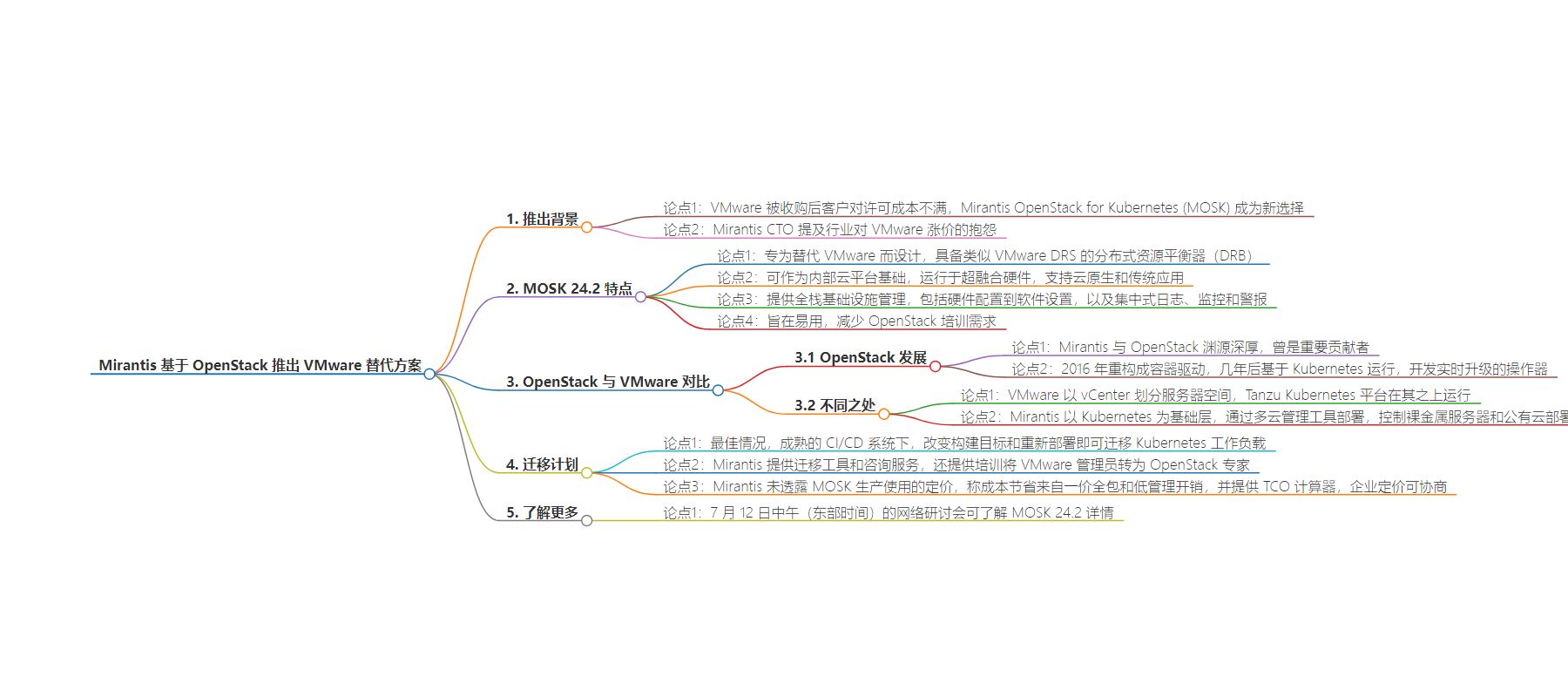包阅导读总结
1. 关键词:Mirantis、OpenStack、VMware、MOSK、替代方案
2. 总结:
Mirantis 推出 MOSK 作为 VMware 的替代方案,旨在解决 VMware 被收购后的许可成本问题。MOSK 基于 OpenStack 构建,具有类似 VMware 的功能,且易于使用。文中还对比了两者的不同方法,并介绍了迁移计划和相关服务。
3. 主要内容:
– Mirantis 推出 MOSK 作为 VMware 客户的新选择
– 原因是 VMware 被收购后许可成本令客户不满
– MOSK 24.2 专为替代 VMware 设计,有新功能 DRB 与 VMware 的 DRS 相当
– MOSK 的特点
– 可作为内部云平台基础,运行云原生和传统应用
– 提供全栈基础设施管理
– 网络服务有多种选择
– 与 OpenStack 和 VMware 的关系
– Mirantis 有 OpenStack 经验,对其进行多次改造
– 对比了 VMware 和 Mirantis 支持 VM 和容器的不同方法
– 迁移计划
– 理想情况迁移简单,否则有工具和咨询服务
– 提供培训将 VMware 管理员转为 OpenStack 专家
– 未透露 MOSK 生产使用的定价
思维导图:
文章地址:https://thenewstack.io/mirantis-builds-on-openstack-to-serve-up-a-vmware-alternative/
文章来源:thenewstack.io
作者:Joab Jackson
发布时间:2024/7/9 21:20
语言:英文
总字数:925字
预计阅读时间:4分钟
评分:83分
标签:Mirantis,开源云平台,容器化云平台,VMware替代品,云管理
以下为原文内容
本内容来源于用户推荐转载,旨在分享知识与观点,如有侵权请联系删除 联系邮箱 media@ilingban.com
VMware customers frustrated with their licensing costs after last year’s Broadcom’s acquisition of VMware have a new option: MirantisOpenStack for Kubernetes (MOSK).
“The world is looking for alternatives to VMware,” said Shaun O’Meara, Mirantis CTO, referencing the complaints in the industry about Broadcom raising its prices on existing VMware customers.
The freshly-released MOSK 24.2 was crafted with VMware in mind, and even comes with a new exclusive feature, called the Distributed Resource Balancer (DRB), which is comparable to VMware’s Distributed Resource Scheduler (DRS) in its ability to more dynamically schedule containers for favorable performance and operating costs.
MOSK can be used as the base for an in-house cloud platform, which runs on hyperconverged hardware, aimed at running both cloud native and legacy applications.
In a press release, Mirantis notes that MOSK offers “full-stack management of the underlying infrastructure, from hardware provisioning to software configuration, plus centralized logging, monitoring, and alerting.” It can be expanded to manage multiple clouds.
Mirantis has aimed to make MOSK as easy to use as possible, minimizing the amount of OpenStack training needed.
OpenStack or VMware?
Mirantis has a long history with OpenStack, the open source cloud computing infrastructure stack, at one point being one the largest contributors to the project. Although it is used in various quarters, OpenStack has never enjoyed the wide adoption of Kubernetes, perhaps due to its complexity.
In 2016, Mirantis reengineered its own distribution to be container-driven, which made it far easier for admins to manage. And a few years later, the company moved its OpenStack distribution to run atop Kubernetes. The company developed its own operator to do real-time upgrades.
“That allowed us to radically change the way OpenStack is managed,” O’Meara said. Users went from upgrading the stack once every year and a half to as much as once a month in some cases.
MOSK is built on the OpenStack 2024.1 “Caracal” and runs on the CephReef open-source software-defined storage technology.
MOSK has three options for providing network services for virtual machines. One is the Open Virtual Network (OVN)software-defined networking (SDN), which appears to becoming the standard for OpenStack, though Mirantis also offers Open vSwitch (OVS) and OpenSDN (formerly Tungsten Fabric).
The new DRB load balancer puts MOSK on equal footing with VMware’s own DRS, O’Meara argued. The duty of the load balancer is to play a Tetris-like game of most efficiently packing workloads into a limited number of servers. For true efficiency, a good resource scheduler will overpack a server, given that not every container will use all its allocated resources, and this requires the ability to move workloads on the fly.
DRB is built on Kubernetes and utilizes the OpenStack monitoring components.
The software makes a decision based on a number of metrics and then communicates with the Nova compute controller to manage the workload.
VMware and Mirantis: Two Different Approaches
MOSK logo
Today, Mirantis is not shy of touting MOSK as a replacement for VMware platforms, noting that container and even VM-based workloads running on VMware ESXi and VMware vSphere could be converted over to OpenStack with minimal disruption.
The approach each company takes to supporting VMs and containers differs pretty radically.
In VMware’s case, vCenter carves up the bare metal servers into spaces for VMs. Its Tanzu Kubernetes platform is then run atop of this environment.
In the case of Mirantis, Kubernetes is the base layer, and it is deployed through the Mirantis Container Cloud, a multicloud management tool, meaning it controls bare metal servers and even deployments on public clouds.
The Mirantis Kubernetes Engine can then be deployed to run Kubernetes workloads (You might remember MKE when it was known as Docker Enterprise, which Mirantis acquired in 2019). MKE workloads then run on OpenStack.
“The big difference is that OpenStack is designed to grow to cloud scale,” O’Meara boasted. “We have customers with thousands of nodes on single clusters.”
Migration Plans
In the best-case scenario. with a mature CI/CD build system in place, an organization could migrate a Kubernetes workload with little more than changing the target of the build and then redeploying the containerized applications to the new environment.
Of course, not every company has that sort of flexibility. So Mirantis offers a set of migration tools, and, should things get really tricky, consulting services to create a migration plan. The customer can do VM migrations as well, either on their own or with consultancy.
Mirantis also offers training to “convert” a VMware admin into an OpenStack expert. Because MOSK runs on top of Kubernetes, a lot of administration for OpenStack has been automated.
“If you got an experienced VMware operator with some solid Linux skills, we can convert them into an OpenStack operator relatively quickly,” O’Meara said.
Mirantis won’t divulge the pricing of MOSK for production use, which is based on per-core usage. Any savings in costs would come from the company’s one-price-includes-all pricing, as well as for lower management overhead, according to O’Meara.
The company provides a TCO calculator, and, as usual, enterprise pricing can be negotiated in many cases.
To learn more about MOSK 24.2, check out this Webinar on July 12, noon Eastern time.
YOUTUBE.COM/THENEWSTACK
Tech moves fast, don’t miss an episode. Subscribe to our YouTubechannel to stream all our podcasts, interviews, demos, and more.
